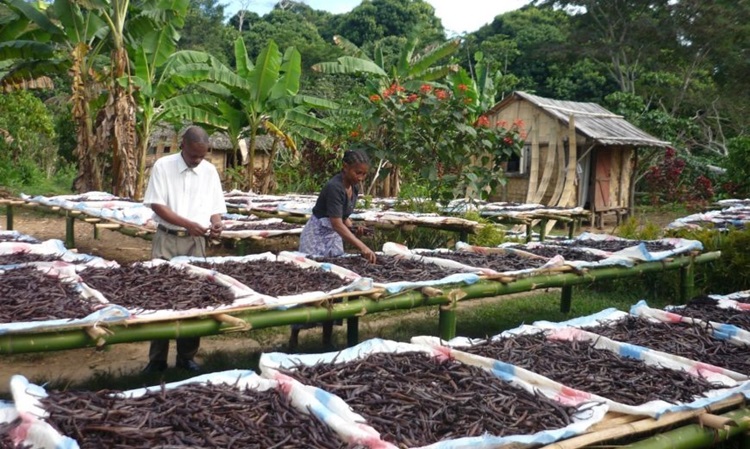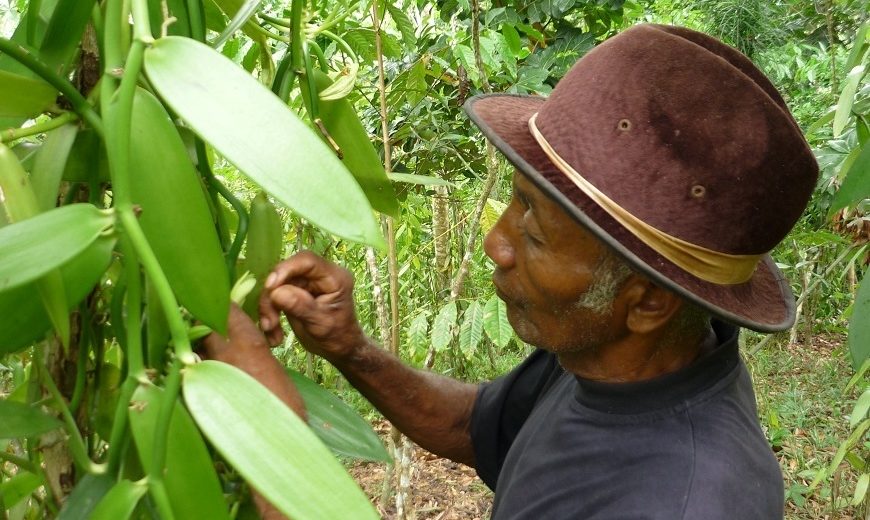With the help of vanilla researcher Hendrik Hänke, Fairtrade took a deep dive into the world of vanilla farmers in Madagascar and Uganda, in order to build understanding around the minimum production and market conditions for vanilla farmers to escape poverty and earn enough for a decent standard of living. Fairtrade certifies approximately 40 vanilla cooperatives in seven countries.
The resulting calculation of living income reference prices for vanilla – the first of their kind – was based on 500 individual household interviews and cross-checking their assessments of feasible productivity, farming and living costs in group discussions with farmer leaders and consultation with industry stakeholders.
Vanilla price volatility closely linked to quality and crime
The price of natural vanilla fluctuates drastically. Long periods of depressed prices caused by excess supply of low-quality pods alternate with dramatic price spikes caused by market shortages, when poverty has led farmers to tear out their vines or when one of the frequent cyclones wiped out production in Madagascar. At times of high vanilla prices, farmers harvest unripe pods to prevent them from getting stolen, flooding the market with low-quality vanilla, and the boom and bust cycle is complete.
Madagascar is by far the largest origin of natural vanilla, producing about 60 percent of the total global volumes, and is among the ten poorest countries in the world. Some 70,000 to 80,000 smallholder farmers, mostly concentrated in the isolated northeast Sava region, depend on vanilla production for a living.
Vanilla pods grow on climbing vines in agroforestry systems. The blossoms – technically an orchid species – open only a few days per year and need to be pollinated by hand, after which the long slender pods take about nine months to mature. Due to the labour-intensive nature of vanilla farming and the delicacy of certain tasks like hand-pollination, the maximum vanilla plot size an average four-member household in Madagascar can manage with their own labour is only one hectare.
The extreme price swings and risk of weather-related loss make farmers reluctant to invest in good agricultural practices and improve their yields, even now that prices are high. This keeps farmers trapped by low productivity, driven to sleep in their fields and hiring guards to protect their harvest from theft.
Uganda is being developed as an alternative origin for vanilla that can help stabilize the supply. The living and farming conditions are quite different from Madagascar, with more crop diversification and two vanilla harvests per year. Part of the purpose of our research was to analyse the minimum price needed to keep vanilla attractive for farmers, as compared to their other cash crops like cocoa and coffee.
Calculating a price that supports a decent living for farmers

A living income reference price is one that would enable an average farmer to earn enough to support a decent standard of living for his or her household, based on certain parameters of farm size and productivity.
Based on this research, we have established living income reference prices for green vanilla in Madagascar at €16.60/kg, and for Uganda at €15.60/kg at farm gate. The price model is based on a diversified farm, growing cash crops like cocoa and coffee, or rice and other food for own consumption besides the maximum manageable vanilla plot size, to fully occupy the available household labour force and contribute to improved income resilience.
The model factors in the local costs of a decent standard of living, including a nutritious diet, decent housing, essential expenses like schooling and healthcare and some savings. In Madagascar, these add up to approximately €3.75 per person per day, and €3.03 per person per day in Uganda.
These price references serve as a tool to help stakeholders work towards a more stable vanilla market, supporting both the supply of high-quality vanilla and livelihoods of vanilla farmers over the long term. Moreover, they empower vanilla farmer organizations to negotiate adequate prices to sustain their vanilla business throughout market fluctuations, and provide an incentive to drive their own productivity and quality improvement programmes.
The living income reference prices are lower than the current market prices, which are around €45 to 50/kg at farm gate. But these prices are likely to drop sooner or later, as was seen after the 2004 market high, when farm gate prices crashed.
Both farmers and buyers of vanilla prefer a stable price to massive fluctuations. The certainty of a price that supports a living income would encourage farmers to invest in their farms and adopt the recommended agricultural practices, leading to increased and more sustainable vanilla production. The reference price – which is higher than the current equivalent Fairtrade Minimum Price at farm gate — could protect farmers even more against extreme price drops, if vanilla buyers voluntarily commit to paying it. The Fairtrade Minimum Price for vanilla is scheduled for review in 2020, taking this research into account.
Ben & Jerry’s Global Values-Led Sourcing Manager, Cheryl Pinto, states: “We want our farmers to do well when we do well. Purchasing through Fairtrade is part of that solution by providing a price floor. But the reference price study shows we as buyers need to do more to support farmers who strive to make vanilla their primary business – enabling them to invest in the productivity, value addition, and diversification needed to close the gap to a living income.”
Natural vanilla is already sustainable from an environmental point of view. A secured living income for vanilla farmers in a more stable market would enable long term growth of this iconic natural flavour, serving farmers as well as the environment.
